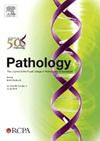急性淋巴细胞白血病与T和b谱系定义标记。
IF 3
3区 医学
Q1 PATHOLOGY
引用次数: 0
摘要
在急性淋巴细胞白血病(ALL)中,细胞质CD3 (cCD3)是t谱系的决定性标志物,CD19加上b细胞标志物是b谱系的决定性标志物。我们确定了23例ALL病例,其中淋巴细胞同时表达cCD3和CD19,这使得谱系分配具有挑战性。这些病例约占cCD3+ ALL的10%,并表达除CD19以外的另外两种b细胞标志物,包括CD79a(76%)、CD22(22%)、PAX5(57%)和CD10(44%)。2例合并T/ b系ALL,均为BCR::ABL1重排阳性。其余21例中,19例中有1例检测到IgH和/或IgK/L重排,21例中有13例(62%)检测到TRG/TRB重排。其他T-ALL特征遗传异常包括NOTCH1突变(7/ 21,33%)、PHF6突变(6/ 21,29%)、JAK3突变(4/ 21,19%)、PICALM::MLLT10、TLX3::BCL11B、TRB::HOXA13、SPTAN1::NUP214和CDKN2A/CDKN2B缺失。在16例显示T-ALL遗传谱的病例中,CD22(2/ 16,13 %)被发现是比CD79a(11/ 15,73 %)、PAX5(8/ 14,57 %)或CD10(7/ 16,44 %)更特异性的附加b谱系标记。我们的数据表明,混合T/B-ALL是极其罕见的,大多数病例与BCR::ABL1和骨髓增生性肿瘤的原细胞危象有关。大多数病例表现为表达异常b细胞标记物的早期t前体淋巴细胞白血病。我们还发现CD19在复发/残留疾病中持续表达(16/ 17,94%),这表明它可能作为治疗靶点和检测这些ALL病例中残留/复发疾病的标志物。本文章由计算机程序翻译,如有差异,请以英文原文为准。
Acute lymphoblastic leukaemia with T- and B-lineage defining markers
In acute lymphoblastic leukaemia (ALL), cytoplasmic CD3 (cCD3) is a defining marker for T-lineage, and CD19 plus additional B-cell marker(s) for B-lineage. We identified 23 ALL cases in which the lymphoblasts expressed both cCD3 and CD19, making lineage assignment challenging. These cases represented approximately 10% of cCD3+ ALL and expressed a median of two additional B-cell markers other than CD19, including CD79a (76%), CD22 (22%), PAX5 (57%) and CD10 (44%). Two cases were mixed for T/B-lineage ALL, both positive for BCR::ABL1 rearrangement. In the remaining 21 cases, IgH and/or IgK/L rearrangement were detected in 1 of 19 cases and TRG/TRB in 13 of 21 (62%) cases. Other T-ALL characteristic genetic abnormalities included NOTCH1 mutations (7/21, 33%), PHF6 (6/21, 29%), JAK3 (4/21, 19%), PICALM::MLLT10, TLX3::BCL11B, TRB::HOXA13, SPTAN1::NUP214 and deletion of CDKN2A/CDKN2B. In the 16 cases that demonstrated a T-ALL genetic profile, CD22 (2/16, 13%) was found to be a more specific additional B-lineage marker than CD79a (11/15, 73%), PAX5 (8/14, 57%) or CD10 (7/16, 44%). Our data suggest that mixed T/B-ALL is extremely rare, with most cases associated with BCR::ABL1 and blast crisis of myeloproliferative neoplasms. The majority of cases represent early T-precursor lymphoblastic leukaemia expressing aberrant B-cell markers. We also showed persistent CD19 expression in relapsed/residual disease (16/17, 94%), suggesting its potential role as a therapeutic target and as a marker for detection of residual/relapse disease in these ALL cases.
求助全文
通过发布文献求助,成功后即可免费获取论文全文。
去求助
来源期刊

Pathology
医学-病理学
CiteScore
6.50
自引率
2.20%
发文量
459
审稿时长
54 days
期刊介绍:
Published by Elsevier from 2016
Pathology is the official journal of the Royal College of Pathologists of Australasia (RCPA). It is committed to publishing peer-reviewed, original articles related to the science of pathology in its broadest sense, including anatomical pathology, chemical pathology and biochemistry, cytopathology, experimental pathology, forensic pathology and morbid anatomy, genetics, haematology, immunology and immunopathology, microbiology and molecular pathology.
 求助内容:
求助内容: 应助结果提醒方式:
应助结果提醒方式:


